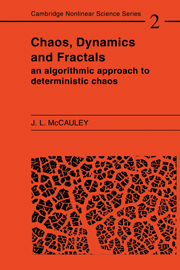Book contents
- Frontmatter
- Dedication
- Contents
- Preface
- Miscellaneous Frontmatter
- Introduction
- 1 Flows in phase space
- 2 Introduction to deterministic chaos
- 3 Conservative dynamical systems
- 4 Fractals and fragmentation in phase space
- 5 The way to chaos by instability of quasiperiodic orbits
- 6 The way to chaos by period doubling
- 7 Introduction to multifractals
- 8 Statistical mechanics on symbol sequences
- 9 Universal chaotic dynamics
- 10 Intermittence in fluid turbulence
- 11 From flows to automata: chaotic systems as completely deterministic machines
- Bibliography
- Index
4 - Fractals and fragmentation in phase space
Published online by Cambridge University Press: 05 October 2013
- Frontmatter
- Dedication
- Contents
- Preface
- Miscellaneous Frontmatter
- Introduction
- 1 Flows in phase space
- 2 Introduction to deterministic chaos
- 3 Conservative dynamical systems
- 4 Fractals and fragmentation in phase space
- 5 The way to chaos by instability of quasiperiodic orbits
- 6 The way to chaos by period doubling
- 7 Introduction to multifractals
- 8 Statistical mechanics on symbol sequences
- 9 Universal chaotic dynamics
- 10 Intermittence in fluid turbulence
- 11 From flows to automata: chaotic systems as completely deterministic machines
- Bibliography
- Index
Summary
Introduction to fractals
Smooth curves, or curves where the slope is at least piecewise well defined, have a definite length. When one measures the length of such a curve to higher and higher precision, by using a sequence of shorter and shorter rulers, for example, then one obtains corrections to the previous length measurement in the form of higher-order decimals, but the leading decimals are not changed if the former length measurement was at all accurate. These curves are the foundation for Euclidean and non-Euclidean geometry and we are familiar with them from standard courses in mathematics and physics. The elliptic orbit of the earth about the sun provides only one of many possible examples of the smooth orbits of integrable dynamics.
In stark contrast with mathematical smoothness, much of nature is made up of collections of fragments whose evolution and form seem at first glance to be beyond the possibility of description in the theory of differential equations, unless ‘random noise’ is included ‘ad hoc’ as an external force. A few examples are coastlines, mountain ranges, aggregates of soot particles, the porespace of sandstone, and the eddy cascade in turbulence.
- Type
- Chapter
- Information
- Chaos, Dynamics, and FractalsAn Algorithmic Approach to Deterministic Chaos, pp. 127 - 150Publisher: Cambridge University PressPrint publication year: 1993

